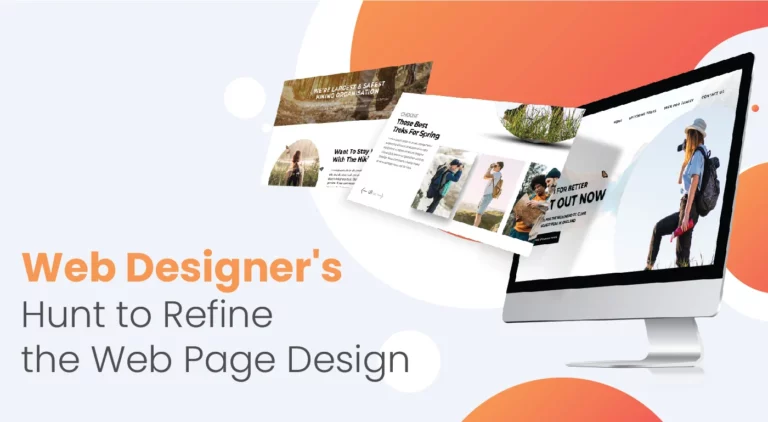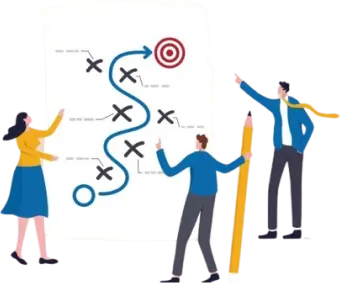29 Apr, 2022 | Web Design Services
Web Designers Hunt to Refine the Web Page Design

Do you need a web designer?
The DIYers and creative minds may try some things to build their website on their own, and that's a lot appreciative for them. It won't make a huge difference as long as it is from the perspective of personal branding, but if you are jumping into the professional market, you need to stand out of the crowd. Web designers not only help you with the improvement of the front end of your site, instead they concentrate on the selection of the design that can accelerate conversion rate as well. Your goal is to develop your standalone identity as a business. So, please leverage their knowledge of years to drive better results. It will be a one-time investment for your business, but, believe us, it will be worth it.Where can I find a web designer ?
To hire web designers, you can connect with the website development companies, design agencies, as well as opt for freelancers. For a wise choice, you must decide and set the end goal of the project. Let's say; you want help with graphics and layout manipulations, then web designers and graphic designers can be the right choice. But, if you have significant goals in your mind or are looking for website revamping, web designers may not be enough. By outsourcing such projects to the web development company, you can reduce the trouble of looking for professionals from different segments to improve the overall quality of the web. Also, you can count on design agencies, if you are looking for designing marketing and sales content like brochures, hoarding designs, promotional content and so on. With set goals, it will be easier for you to decide on the options and select the optimum one for your requirement. Refining web page design involves adhering to established guidelines. Learn about the web standards for professional web design to ensure your site meets industry expectations. If you are on a tight budget and like to hire an individual web designer, you can explore freelance platforms like Freelancer, Fiverr, Appen, and several others. Don't trust on the free resource hiring platforms, as they don't have any tools embedded for smooth functioning. You can count on the freelance platforms, as they have set tools like task management, time calculation and communication portal to smoothen your work with the resources sitting across the oceans. Working with freelancers directly via non-reliant platforms can be an informal and lethargic task, but with professional platforms, you can easily manage it. Also Read: Hire Graphic Designers in LondonHow to decide on the best web designer?
Hiring is a tedious process, and as long as you don't have HR on board to help you select the best resource, you have to be extra cautious. While you are going through the profile of the company or individual resource, don't blindly trust what's written. Here's what to count on:- Look for the portfolio of the web designer. It will solve the riddle for you.
- Review the profile and check with the client testimonials.
- Ask for the quotation and compare the pricing offered by companies and individuals.
- Enquire about the additional services they are offering. It can be helpful for long-term association with the company.
- Tools that can be leveraged to communicate smoothly.
Frequently Asked Questions
One effective technique for creating a user-friendly navigation menu on a web page is using a clear and concise labeling system. Use labels that are intuitive and easily understood by your target audience. Another technique is to organize your navigation menu in a logical and consistent manner, such as grouping related items together or following a chronological or alphabetical order. Additionally, consider using drop-down menus or hamburger menus to simplify the navigation process for users. Test your navigation menu with real users to ensure it is clear and easy to use.
Typography choices can greatly impact the readability and visual hierarchy of a web page design. The choice of font, font size, and spacing can affect how easy it is for users to read and navigate through the content. For example, sans-serif fonts are usually more legible on screens and at small sizes, while serif fonts are better for longer blocks of text. Additionally, proper line height and spacing between letters and paragraphs can make a significant difference in the overall readability and user experience. By using a consistent hierarchy of font sizes and boldness, designers can guide the user’s eye through the page and emphasize important information.
To optimize your images and media for web page design, start by choosing the right format. JPEG is best for photographs, while PNG is preferable for images with text or transparency. For other media like video, use MP4 or WebM format. Next, compress your images and media files to reduce their size without sacrificing quality. There are various online tools, plugins, and software available to help with this. Make sure to also use descriptive and relevant file names and alt text for your images and media files. This helps with SEO and accessibility for users with disabilities. Finally, minimize the number of images and media files on your page to ensure fast loading times. By following these best practices, you can optimize your images and media for web page design, improving user experience and SEO.
Whitespace, or negative space, is an essential component of good web page design. It helps to improve readability, direct focus and attention, and create a visually balanced layout. When creating a web page design, use whitespace deliberately to create a sense of hierarchy and to guide the user's eye to the most important content. Effective use of whitespace means not cluttering the page with too many elements, but instead using visual cues like color and spacing to create contrast and organize content. Group similar types of content together, use typography to create visual hierarchy, and break up large blocks of text with whitespace to make it more readable. Remember, less is often more when it comes to web design, so don't be afraid to leave blank space and allow your design elements to breathe.
Color schemes play a crucial role in determining the visual appeal and usability of a web page design. In the UK, you should keep in mind the cultural connotations associated with different colors. For instance, red is often associated with danger, passion, and excitement, while blue connotes trust, stability, and sophistication. A well-designed color scheme can help increase the readability of your website and make it easier for users to navigate your site. Additionally, it can evoke positive emotional responses and increase the chances of users engaging with your content. Lastly, using contrasting colors can create a sense of hierarchy and highlight important information, making it easier for users to find what they're looking for.

